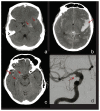Hemorrhagic stroke: aneurysmal subarachnoid hemorrhage
- PMID: 21568235
- PMCID: PMC6189155
Hemorrhagic stroke: aneurysmal subarachnoid hemorrhage
Abstract
Non-traumatic subarachnoid hemorrhage (SAH) represents approximately 5-6% of all strokes. Morbidity and mortality rates remain high, but accurate diagnosis using clinical assessment and neuroimaging, critical care management, and early treatment using either surgical or interventional techniques have improved overall outcomes. This, the fifth in a Missouri Medicine series on stroke, summarizes the clinical and imaging aspects of making the diagnosis of SAH, critical care management of the patient, treatment options, and factors important in prognosis.
Figures





References
-
- Stevens, et al. The Role of Mechanical Ventilation in Acute Brain Injury. Neurol Clin. 2008:543–563. - PubMed
-
- Byyny, et al. Sensitivity of Noncontrast Cranial Computed Tomography for the Emergency Department Diagnosis of Subarachnoid Hemorrhage. Annals of Emergency Medicine. 51(6):697–703. - PubMed
-
- Greving, et al. Cost-effectiveness of preventative treatment of intracranial aneurysms. Neurology. 2009;73:258–265. - PubMed
Publication types
MeSH terms
LinkOut - more resources
Full Text Sources
Medical
